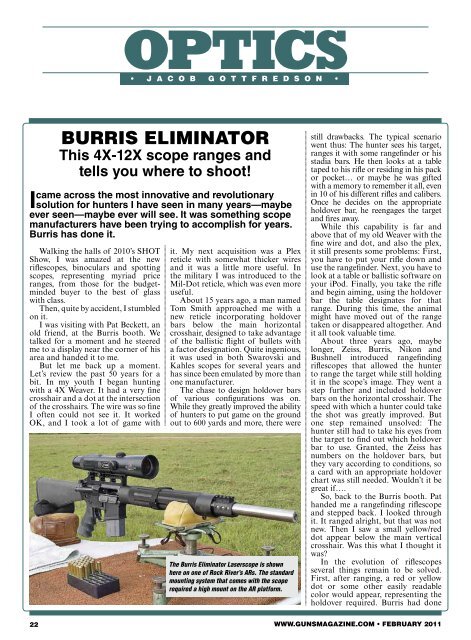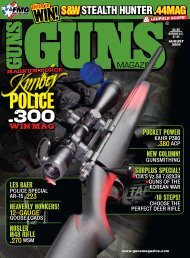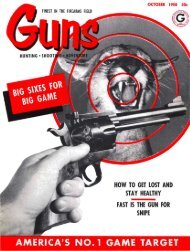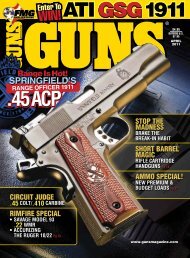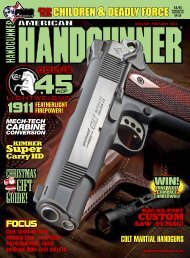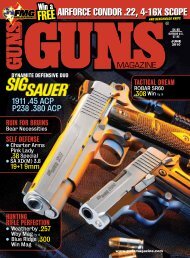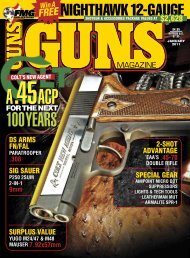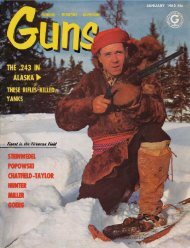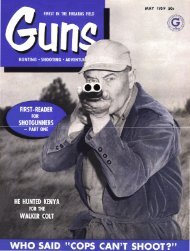Guns 2011-02.pdf - Jeffersonian
Guns 2011-02.pdf - Jeffersonian
Guns 2011-02.pdf - Jeffersonian
Create successful ePaper yourself
Turn your PDF publications into a flip-book with our unique Google optimized e-Paper software.
• J A C O B G O T T F R E D S O N •<br />
Burris Eliminator<br />
This 4X-12X scope ranges and<br />
tells you where to shoot!<br />
came across the most innovative and revolutionary<br />
I solution for hunters I have seen in many years—maybe<br />
ever seen—maybe ever will see. It was something scope<br />
manufacturers have been trying to accomplish for years.<br />
Burris has done it.<br />
Walking the halls of 2010’s SHOT<br />
Show, I was amazed at the new<br />
riflescopes, binoculars and spotting<br />
scopes, representing myriad price<br />
ranges, from those for the budgetminded<br />
buyer to the best of glass<br />
with class.<br />
Then, quite by accident, I stumbled<br />
on it.<br />
I was visiting with Pat Beckett, an<br />
old friend, at the Burris booth. We<br />
talked for a moment and he steered<br />
me to a display near the corner of his<br />
area and handed it to me.<br />
But let me back up a moment.<br />
Let’s review the past 50 years for a<br />
bit. In my youth I began hunting<br />
with a 4X Weaver. It had a very fine<br />
crosshair and a dot at the intersection<br />
of the crosshairs. The wire was so fine<br />
I often could not see it. It worked<br />
OK, and I took a lot of game with<br />
it. My next acquisition was a Plex<br />
reticle with somewhat thicker wires<br />
and it was a little more useful. In<br />
the military I was introduced to the<br />
Mil-Dot reticle, which was even more<br />
useful.<br />
About 15 years ago, a man named<br />
Tom Smith approached me with a<br />
new reticle incorporating holdover<br />
bars below the main horizontal<br />
crosshair, designed to take advantage<br />
of the ballistic flight of bullets with<br />
a factor designation. Quite ingenious,<br />
it was used in both Swarovski and<br />
Kahles scopes for several years and<br />
has since been emulated by more than<br />
one manufacturer.<br />
The chase to design holdover bars<br />
of various configurations was on.<br />
While they greatly improved the ability<br />
of hunters to put game on the ground<br />
out to 600 yards and more, there were<br />
The Burris Eliminator Laserscope is shown<br />
here on one of Rock River’s ARs. The standard<br />
mounting system that comes with the scope<br />
required a high mount on the AR platform.<br />
still drawbacks. The typical scenario<br />
went thus: The hunter sees his target,<br />
ranges it with some rangefinder or his<br />
stadia bars. He then looks at a table<br />
taped to his rifle or residing in his pack<br />
or pocket… or maybe he was gifted<br />
with a memory to remember it all, even<br />
in 10 of his different rifles and calibers.<br />
Once he decides on the appropriate<br />
holdover bar, he reengages the target<br />
and fires away.<br />
While this capability is far and<br />
above that of my old Weaver with the<br />
fine wire and dot, and also the plex,<br />
it still presents some problems: First,<br />
you have to put your rifle down and<br />
use the rangefinder. Next, you have to<br />
look at a table or ballistic software on<br />
your iPod. Finally, you take the rifle<br />
and begin aiming, using the holdover<br />
bar the table designates for that<br />
range. During this time, the animal<br />
might have moved out of the range<br />
taken or disappeared altogether. And<br />
it all took valuable time.<br />
About three years ago, maybe<br />
longer, Zeiss, Burris, Nikon and<br />
Bushnell introduced rangefinding<br />
riflescopes that allowed the hunter<br />
to range the target while still holding<br />
it in the scope’s image. They went a<br />
step further and included holdover<br />
bars on the horizontal crosshair. The<br />
speed with which a hunter could take<br />
the shot was greatly improved. But<br />
one step remained unsolved: The<br />
hunter still had to take his eyes from<br />
the target to find out which holdover<br />
bar to use. Granted, the Zeiss has<br />
numbers on the holdover bars, but<br />
they vary according to conditions, so<br />
a card with an appropriate holdover<br />
chart was still needed. Wouldn’t it be<br />
great if….<br />
So, back to the Burris booth. Pat<br />
handed me a rangefinding riflescope<br />
and stepped back. I looked through<br />
it. It ranged alright, but that was not<br />
new. Then I saw a small yellow/red<br />
dot appear below the main vertical<br />
crosshair. Was this what I thought it<br />
was?<br />
In the evolution of riflescopes<br />
several things remain to be solved.<br />
First, after ranging, a red or yellow<br />
dot or some other easily readable<br />
color would appear, representing the<br />
holdover required. Burris had done<br />
22<br />
WWW.GUNSMAGAZINE.COM • FEBRUARY <strong>2011</strong>


